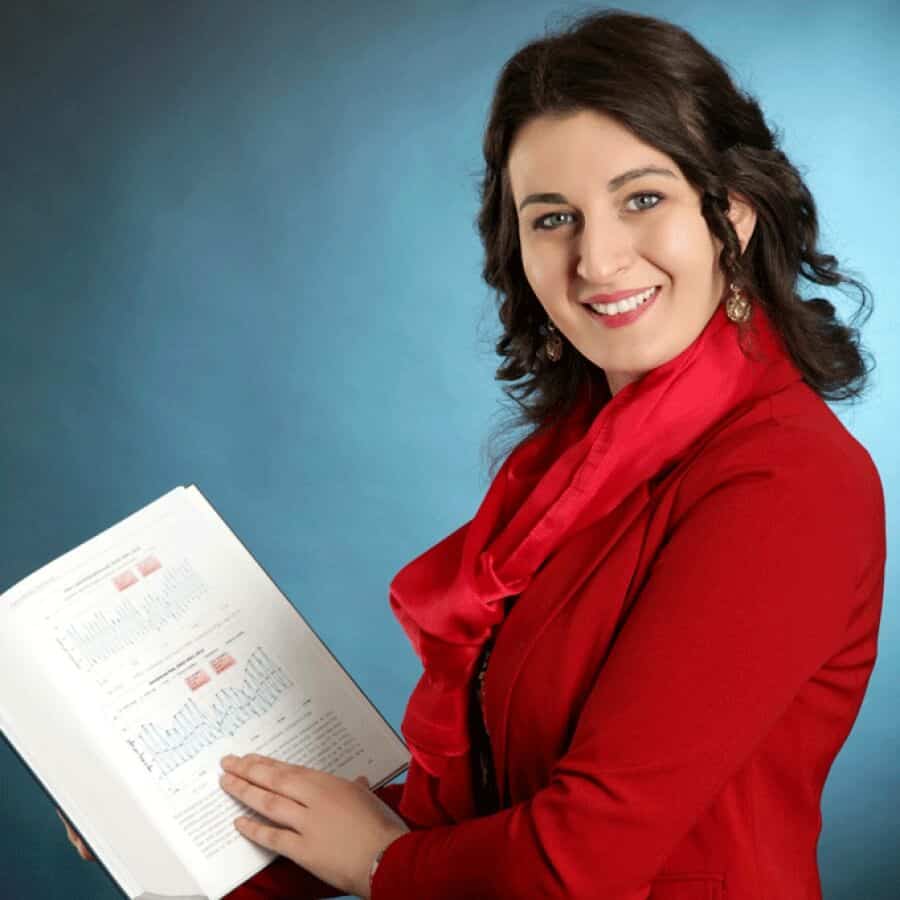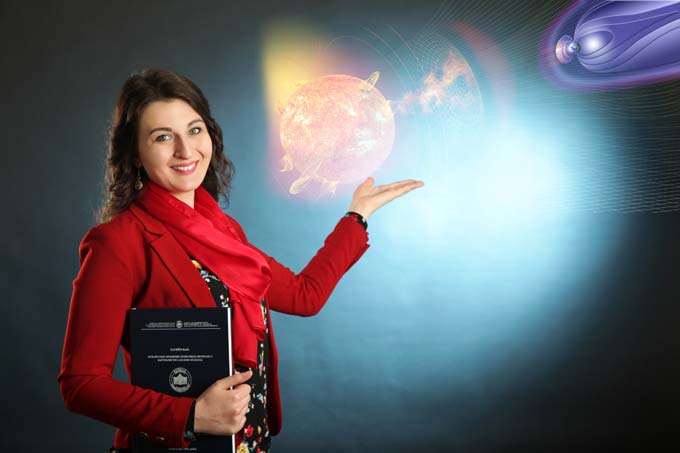After finishing High school, and only 18 at the time, Randa Natras (26) was uncertain about her life career choice. However, her passion for exploring Space, and for math and physics, brought her to studies of the scientific field called Satellite Geodesy. Today, Randa is a recognized young scientist who is discovering how space weather and changes in the ionosphere affect the modern technologies we use on Earth. This year, she was one of only 14 experts from all around the world who received financial support from the IAG (the International Association for Geodesy) to participate in an important scientific convention in Japan. In an interview with Youth Time magazine, she updates us about her impressions from Japan, her latest research, and her plans for the future.
Dear Randa, it sounds a bit like science fiction when we hear the term Satellite Geodesy, and that is exactly what your field of interest is. Can you explain to our readers, simply, what the field of satellite geodesy studies?
Satellite Geodesy studies the Earth using observations from artificial, mostly near-Earth, satellites in order to measure the form and dimensions of the Earth, to determine the Earth’s gravity field, to monitor geodynamical phenomena (the Earth’s rotation and polar motion), and to determine the location of objects on its surface (3D positioning and navigation). It studies observational and computational techniques which allow solutions of the noted geodetic tasks. There are several satellite geodetic measurement techniques. Satellites can be observed with ground-based instruments, e.g. the Global Navigation Satellite System (GNSS), which is used in my current research. Also, a satellite may carry an instrument or sensor to observe the Earth or to track or to be tracked by another satellite. Through the years, the applications of Satellite Geodesy have become extremely evolved. Today its applications are enormous. As far as my research is concerned, Satellite Geodesy is applied to determine the atmosphere’s tomography and to monitor the state of atmospheric layers.
Randa Natras
How did you decide to study the science of geodesy, and what drew you to it?
I decided to study geodesy during my last months in high school. It was difficult at that age to decide what I should do professionally. I was very passionate about math and physics, and I often represented my school in competitions in these subjects, mostly in my own country. My other interest was study of the Earth and Space, so I liked geography as well. In the end, I chose to study geodesy, because it combines geography, physics, and math. I started to prepare myself for the entrance examination in math just few months beforehand, and I passed it successfully. I was the second, according to my entrance examination score, on the list of students admitted to the Faculty of Civil Engineering at the University of Sarajevo. I also received the special recognition of Charter of the University of Sarajevo as the best student in the first and second cycle of studies in the Faculty of Civil Engineering.
Tell us more about your work with Dr. Medzida Mulic, Professor at the Faculty of Civil Engineering at the University of Sarajevo. Was she the one who got you interested in this kind of science?
I knew Dr. Medzida Mulic from the third year of my Bachelor’s studies, when I took her courses in Satellite Geodesy. She got me interested in the field, and I wanted to carry out my Bachelor’s thesis under her supervision. The topic was about physical influences on GNSS measurements. I expanded my knowledge in Satellite Geodesy and had a very good relationship with my supervisor. During my Master’s studies I signed up for more of Dr. Mulic’s classes in Satellite Geodesy, and we started to discuss possible master’s thesis topics. She suggested that I investigate the upper part of the atmosphere, called the ionosphere. It was a new research area not only for the Department of Geodesy at the University of Sarajevo, but also for universities in all of Bosnia and Herzegovina and neighboring countries.
Since we are talking about a highy specialized scientific field, you must occasionally find it hard to find the appropriate literature for your research. How do you cope with this problem? Do some of your colleagues from abroad sometimes help?
Yes, I have encountered challenges with finding the appropriate literature during my master’s thesis work. There were no books or publications at the Faculty for my research, and I did not have access to all literature from across the globe on the internet. My supervisor had contacts with researchers from abroad, and she provided me important literature for my research. I was aware that I would need more scientific education in the field. I searched on the internet and found calls for participants in the extended workshop of Space weather effects on GNSS at the International Center for Theoretical Physics Abdus Salam (ICTP) in Trieste, Italy. I contacted my supervisor right away and applied, and was accepted. I spent two weeks there and found that the workshop was very valuable for my research. For the first time, I was able to meet researchers from around the globe, get information for my work, and gain access to the literature in the ICTP’s library. I received feedback on my research and suggestions and recommendations for further work as well.
You were among only 14 young scientist from all over the world who received financial support from the IAG (International Association for Geodesy) to participate and give oral presentations at an important scientific symposium in Japan. What was the initial feedback from international colleagues after you presented your work?
Yes, I was selected as one of the recipients of financial aid from the IAG, together with thirteen other young scientists from all over the world, to come to Japan and give oral presentations at the international scientific assembly. It was one of the happiest moments in my life so far.
The initial feedback from international colleagues wase very supportive. Researchers expressed their willingness to collaborate. They have seen what kind of research was being conducted in Bosnia and Herzegovina, and they want to begin collaborating with the University of Sarajevo in this field of research. Having graduated from the M.Sc. program, I am no longer educationally or professionally connected to the University of Sarajevo, so I made personal contacts with them. They were very willing to give suggestions and recommendations for my further research, which I really appreciate.
What you are working on is very interesting – you are researching the weather in space and changes in the ionosphere that affect the modern technologies we use on Earth. Can you tell us more about this?
I research the state of the upper layer of the atmosphere – the ionosphere – above Bosnia and Herzegovina (BiH), together with the effects of space weather on the ionosphere and the lithosphere-ionosphere coupling process before and after earthquakes. For ionospheric study, measurements from Global Navigation Satellite Systems (GNSS) were used, for extracting the total electron content along the signal’s path in the ionosphere. Also, additional data were applied such as indices of solar activity, the near-Earth environment, and the Earth’s magnetic field to characterize space weather effects, available from research institutions around the world, via satellites, spacecraft, and observatories that provide this information free of charge.
The ionosphere is the ionized region of the upper atmosphere, lying between about 50 kilometers up to several thousand kilometers above the Earth’s surface, which contains free electrons and ions. GNSS signals, transmitted from satellites (at an altitude of about 20 200 km above the Earth) to user receivers (on the Earth’s surface), pass through the ionosphere, where they are effected by free electrons, as well as by the damaging effects of space weather. This atmospheric layer influences signal propagation and consequently introduces errors in GNSS-based applications, such as positioning and navigation, and can affect the accuracy, reliability, and availability of the GNSS system. Thus, atmospheric effects have to be determined and considered in applications which rely on satellite geodesy.
The state of the ionosphere is highly variable in space and time, which makes it difficult to model and predict. The sun has a primary influence on conditions in the ionosphere. Therefore, these studies can contribute to a better understanding of the effects of solar activity on the Earth, as well as space weather effects.
Did you make some useful contacts in Japan, and will there be opportunities for you to cooperate with some of your colleagues in this field abroad?
Participation at the IAG-IASPEI scientific assembly gave me the opportunity to meet many researchers from around the world and make new contacts. We talked about research collaboration in the near future and the possibility of pursuing a PhD in the field. I hope that some of the connections that I made in Japan will result in scientific cooperation.
Very soon, you are leaving for a nine month research program in Vienna, where you will be able to continue your work at the University of Technology. What are your expectations, would you like to stay there and work?
Thanks to an Ernst Mach Grant from the Austrian Agency for International Cooperation in Education and Research (OeAD-GmbH), I now have chance to spend nine months at the University of Technology in Vienna. There I will have access to facilities and literature needed to conduct further research in ionospheric modeling. It will provide me the opportunity to bring my previous research to a new level and contribute to the current and future GNSS and atmospheric research, especially for the region of Bosnia and Herzegovina and the Western Balkans. This could also be a good basis for conducting further investigation into the ionospheric variability of that region. I believe that this research will provide me a good scientific experience and further development to start my professional carrier in this area and pursue a PhD. If I get the opportunity to extend my research stay and work there, I would use it for my further education and development and scientific contribution as well.
What is the next step in your career, and what is your biggest dream as a scientist?
My aim is to expand my knowledge and research in this scientific field, so my next step would be to pursue a PhD. I hope that new opportunities will appear to take me in that direction. My carreer plans are related to work and research in the area of GNSS positioning and navigation, as well as atmospheric and space weather studies. As far as my big dream is concerned, I would say that it is to have the opportunity to work at some of the world’s best scientific institutions, where I will be able to contribute to progress in science and technology.
Photos: Anel Alijagic, INFOT
Support us!
All your donations will be used to pay the magazine’s journalists and to support the ongoing costs of maintaining the site.
Share this post
Interested in co-operating with us?
We are open to co-operation from writers and businesses alike. You can reach us on our email at [email protected]/[email protected] and we will get back to you as quick as we can.











